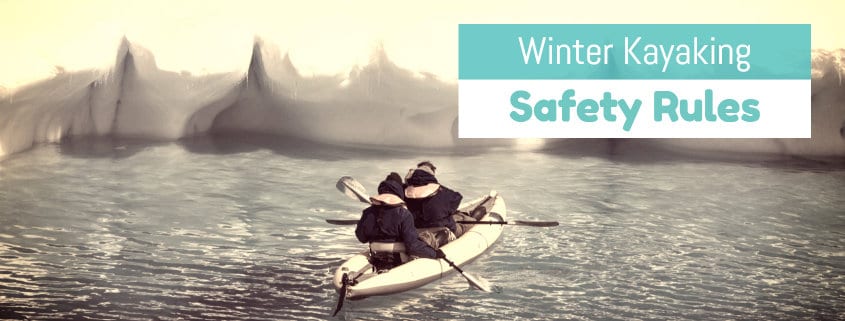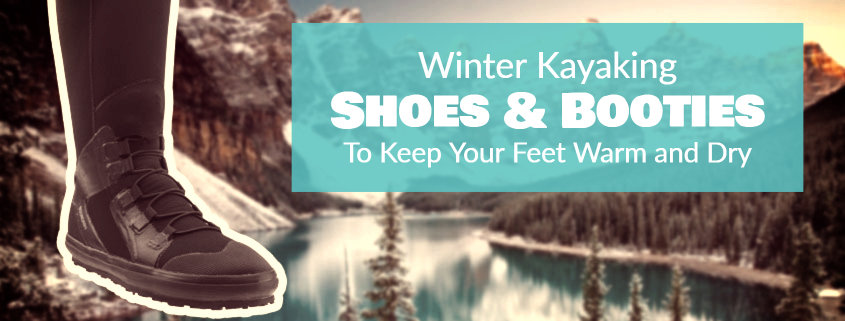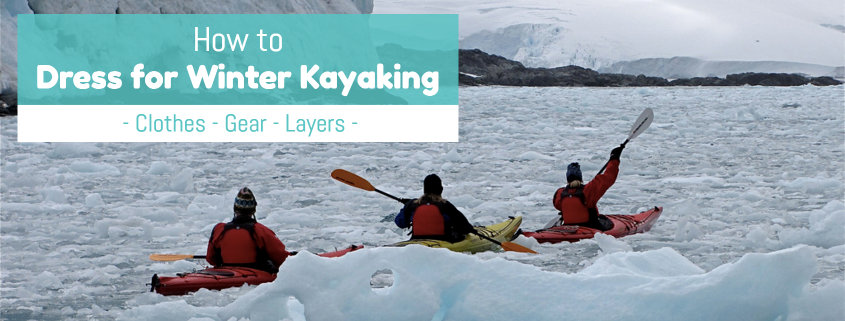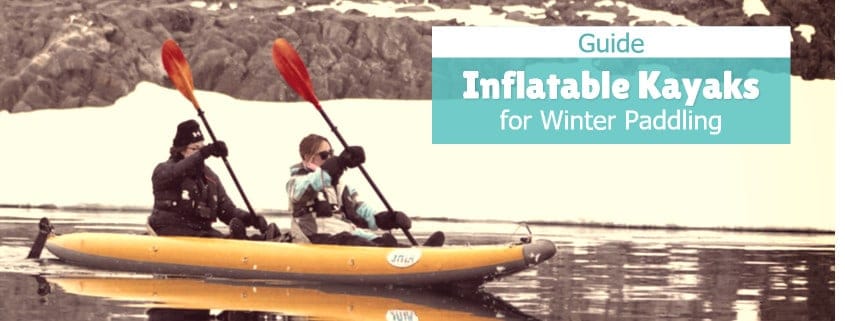Less daylight and colder temperatures shouldn’t keep you from getting out on the water with your kayak, but after the warm season ends, you need to be prepared for maximum safety.
People die every year from capsizing in cold water. Even the best paddlers can fall victim to the dangers of cold-water immersion if they don’t follow basic winter kayaking safety precautions.
You might be asking, “Is it safe to kayak in the winter?”
It is only safe to kayak during winter if you are fully prepared for the extremities of submerging in freezing-cold water.
The primary hazard is not the water itself, but the cold. Hypothermia develops quickly in cold water. The resulting loss of dexterity and exhaustion leads to drowning. The shock experienced from entering cold water can do the same.
Here are the essential safety guidelines & tips to winter kayaking:
Contents
Plan in Advance
Going on a winter kayaking trip can’t be a spontaneous decision. You must plan well ahead. This involves:
- Selecting the location and route
- Choosing the right time (based on weather forecasts)
- Having suitable clothing for winter kayaking
Understand the likely ice cover, wind speed/direction, etc. before finalizing your plan.
The 120°F rule – Winter kayaking safety precaution 101
The 120° Fahrenheit rule states that if the sun of the air and water temperature is below 120°, you need to wear a wetsuit or a drysuit if you set out on the water.
Falling into icy cold water is shocking even to the best trained bodies. If you are not properly dressed for submersion, you have no chance of getting out. This means that dressing for the temperature of the water is the primary way kayakers can prevent hypothermia. The NOAA has temperature info for most US waters.
Here is a guide for when to wear a wetsuit and when to wear a drysuit for winter kayaking:
| WATER TEMP | RISK OF HYPOTHERMIA | CLOTHING |
|---|---|---|
| 70 °F (ca. 21 °C) < | Low | 3 mm wetsuit or shorty |
| 60 – 70 °F | Moderate | 5 mm wetsuit |
| 50 – 60 °F | High | Drysuit or 7 mm wetsuit, or wetsuit with dry-top |
| > 50 °F (ca. 10 °C) | Extreme | Drysuit |
Is it ever too cold to kayak?
Not really no, there is no minimum safe water temperature for kayaking. As long as your lake hasn’t frozen over and you wear proper clothing, you can go kayaking in freezing waters. Weather permitting of course.
Are you prepared for the extremities of winter kayaking? That is a different question.
Learn to layer your clothing
You need to master the art of layered clothing if you want to stay comfortable during a full day of winter paddling.
The air temperature changes during the day, your body temperature changes when you are resting, etc. You need to be able to add and remove layers of clothing to keep you dry and comfortable.
TIP: Read this detailed article on what you should wear for winter kayaking.
In short, you have 3 layers:
- Base layer: This layer keeps moisture away from your body.
- Middle layer: This is the insulation layer, which keeps you warm.
- Outer layer: This layer deals with the elements, such as rain and wind.
If you use a wetsuit, your base layer is the wetsuit itself.
If you use a drysuit or a dry-top, that will be your outer layer. Check out this detailed guide on kayaking drysuits if you are considering buying one.
Keep your extremities (head, hands, feet) warm
Your head plays a vital role in the temperature regulation of your body. Not to mention the fact that your body can reduce circulation to your hands and feet in cold weather, because it prioritizes our vital organs over our extremities.
You need to keep your head, hands and feet dry and warm, so get:
- specialized winter kayaking gloves,
- shoes or booties,
- and headwear.
Safety gear for winter kayaking trips
Depending on where you will paddle and how long your journey will take, you should take some safety gear with you.
Here is a checklist of winter kayaking safety equipment you should consider, depending on where and for how long you plan on paddling.
- Extra set of warm clothing in a watertight dry bag
- Emergency paddle
- Rescue stirrup
- Emergency blanket
- Bothy shelter
- Firestarter
- First aid kit
- Communication tools
- Personal locator beacon
- Compass
Winter kayaking is an amazing hobby. Keep the above in mind, be prepared, and have a blast! Check out my winter kayaking guide to learn more.
Never kayak alone during the winter
Paddling alone during the summer is fine if you’re an able kayaker and wear a PFD of course.
But if you go out during the colder months, you need to bring a friend along for the trip.
You never think anything is going to happen, but just in case it does, you will need some help getting yourself back together again.
Let others know that you are going kayaking
Even though you have a paddling buddy at your side, you should tell someone where you will be going, and what your planned schedule is.
Tell the person you will check in when you finish your trip to let them know everything is fine.
Check the weather report
A sunny winter day can quickly turn into a windy, rainy winter day. Wind creates waves on the water, and extra wind chill for your body to endure. Rain is very unpleasant as well.
Light snowfall is usually OK.
Check the weather reports before you head out, and make sure the weather conditions will remain safe throughout the duration of your kayaking trip.
It’s best to choose calm winter days for your paddling adventures.
Stay close to shore
The weather conditions can shift in a flash and you have to be capable of getting back to land safely.
Wind blowing against you can make returning to shore a nightmare if you are too tired, so make sure you always have enough energy for the return trip.
Time flies by when you are having fun, so it’s easy to lose track of how far you’ve come, and how far you need to go.
Fear the fog
At certain times of year (fall and early spring in the Northern hemisphere), fog can form over cold water and ice sheets.

If the fog is particularly dense, you will not be able to see much. This can be pretty bad if you’re out in the middle of a lake and not know which way to go.
For this reason, you should always have a compass with you and know your bearings.
As I mentioned, this is especially important on larger bodies of water where you may be further from shore.
Learn the ice on the lake
Ponds and lakes will freeze over during cold winter months. Freezing starts from the shore and progresses inwards, with spring thawing starting along the shore as well.
Navigating your way at the edge of ice sheets is amazing, but also can be tough and dangerous.
Bracing on the ice
If your path becomes narrow, you will probably need to push yourself through the ice.
Remember that black ice is weak, as it is waterlogged. It will probably break under the pressure of a paddle, so don’t lean against it.
Only lean on clear or white ice.
Also, your paddle blade might break if you apply too much weight when pushing against the ice. Needless to say, a broken paddle is the last thing you want out on icy waters.
Wind, currents, and ice sheets
There is another inherent risk of navigating through ice sheets: if there is wind or currents near the surface of the water, capsizing can become deadly as you may be carried under an ice sheet. This can happen even if you are wearing a PFD.
Do not go into frozen lakes on windy days at all!
Know how to re-enter your kayak when you capsize
You WILL fall into the water sooner or later, and you need to be able to get back into your kayak. The chance of capsizing is the same during the winter as in the summer, but the consequences can be disastrous because of the cold.
Practice the technique of re-entering your kayak during the warm summer months, until it becomes second nature. This skill is a basic kayaking safety precaution every paddler needs to learn.
DO NOT go paddling in the winter if you do not know how to re-enter your kayak!
Hypothermia can develop quickly in freezing water, and the longer you stay in the water, the greater the chance.
Even if you are wearing a drysuit, staying in the water for a long time can lead to hypothermia.
Always wear your PFD
This should go without saying, but I’m amazed at how many people I see without some sort of flotation device on.
The good part of wearing a life vest during the winter is that it provides an additional layer of warmth.
Here are some great kayaking PFDs I can recommend.
Take a Course
It is a good idea and actually a lot of fun to take a kayak rescue course.
You will learn the correct techniques of wet exit, self-rescue, and even how to help other capsized paddlers get back into their boat without you falling over as well.
There are even specialized winter kayak courses, where among other things, you will submerge into icy waters and experience the shock in a controlled environment.
I’ve taken a course like this and believe me. You are not truly prepared for re-entry in icy waters until you experience it first hand. Here is a preview.
Know your skills and limits
If you’ve gotten this far in this article, you’ll already be familiar with the dangers of winter kayaking, and how to stay safe. This is all theory until you get out there.
Conditions can get pretty rough during the winter months. The cold water, wind, waves and ice sheets are not to be taken lightly.
You need to be a strong paddler, capable of dealing with falling into icy water, rescuing yourself, and perhaps others as well. You need to know how to navigate through ice sheets and fog. You have to prepare.
Take a hard look at your skills and limits before heading out.
Regularly check certain things
Since the cold water splashing at you and your kayak can freeze pretty quickly, you’ll need to keep an eye on a few things while kayaking during winter.
Splashing water and freezing temperatures can cause ice buildup on the kayak, leading to the freezing of the items kept on the deck. If you don’t regularly monitor these items and break the ice formed, you may not be able to use them when needed!
Here are a few tips on what to check regularly in freezing temperatures:
- Your sprayskirt, paddle float, or bilge pump may freeze, keep checking them.
- The usual deck bungee cord becomes inelastic when frozen. If you know temperatures will be sub-0°C, using leather deck lines is better.
- Keep an eye on the movement of pack ice; it moves with the wind and the water current and can block your way making it very difficult to paddle.
- The shoreline will become icy and slippery. If it gets covered with blocks of ice, it becomes almost impossible for you to land the kayak safely.
- Look out for signs of hypothermia in yourself as well as your kayak buddies. Extreme shivering and changes in mental capability can adversely affect your expedition.
Carry adequate food and drinks
Kayaking is an intense physical activity and you’ll need power to paddle your way through tough waters. Even though you may not sweat much, you’ll need to keep yourself hydrated.
So, carry enough water (inside a thermos to avoid freezing) and snacks to keep yourself active. You can’t afford to let your energy levels drop; it can prove to be lethal!





